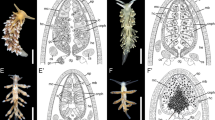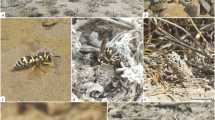Abstract
The rare ctenophore Haeckelia rubra (formerly Euchlora rubra) has long been known to have nematocysts rather than colloblasts in its tentacles. Five specimens were collected in the San Juan Archipelago, Washington State, USA in 1980 and 1981, and their feeding behavior was observed in the laboratory. We found that H. rubra readily eats the tentacles of a medusa, Aegina citrea, whose nematocysts (apotrichous isorhizas) are nearly identical in morphology to the nematocysts of the ctenophore. When H. rubra was offered 16 other species of hydromedusae and 1 siphonophore in the laboratory, the ctenophores showed little or no tendency to ingest these potential prey items. In addition to its routinely positive response to A. citrea, the ctenophore could be induced by manipulation and starvation to accept and ingest bits of the bodies of 4 additional species of hydromedusae and 1 siphonophore. These results, combined with the histological and rearing experiments of other investigators, leave little doubt that the nematocysts in H. rubra are not endogenous, but are “kleptocnidae” similar to those nematocysts retained and subsequently used by some species of nudibranchs that feed on Cnidaria. A close phylogenetic link between the Cnidaria and the Ctenophora is most unlikely.
Similar content being viewed by others
Literature cited
Barnes, R. D.: Invertebrate zoology, 4th ed. 1 089 pp. Philadelphia: Saunders College 1980
Barrington, E. J. W.: Invertebrate structure and function, 2nd ed. 765 pp. New York: John Wiley & Sons 1979
Bode, H. and K. Flick: Distribution and dynamics of nematocyte populations in Hydra attenuata. J. Cell Sci. 21, 15–34 (1976)
Borradaile, L. A. and F. A. Potts: The invertebrata, 3rd ed. 795 pp. Cambridge: University Press 1959
Carré, C. et D. Carré: Les chidocysts du cténophore Euchlora rubra (Kölliker 1853). Cah. Biol. mar. 21, 221–226 (1980a)
Carré, D. and C. Carré: On triggering and control of cnidocyst discharge. Mar. Behav. Physiol. 7, 109–117 (1980b)
Chiu, S. Y. (=Qiu, S. Y.): On the nematocyst-bearing ctenophore Euchlora rubra Kölliker from Xiamen Harbour. Oceanologia Limnol. sin. 11, 255–258 (1980). [In Chinese, with English Abstract]
Chun, C.: Die Ctenophoren des Golfes von Neapel. Fauna Flora golf Neapel. 1, 1–313 (1880)
Conklin, E. J. and R. N. Mariscal: Feeding behavior, ceras structure, and nematocyst storage in the aerolid nudibranch, Spurilla neapolitana (Mollusca). Bull. mar. Sci. 27, 658–667 (1977)
Dunlap, H. L.: Oogenesis in the Ctenophora, 230 pp. Ph.D. dissertation, University of Washington, Seattle, Washington 1966
Edmunds, M.: Protective mechanisms in the Eolidacea (Mollusca Nudibranchia). J. Linn. Soc. (Zool.) 46, 27–71 (1966)
Gegenbauer, C.: Studien über Organisation und Systematik der Ctenophoren. Arch. Naturgesch. 22, 163–205 (1856)
Goy, J.: Les hydroméduses de la mer Ligure. Bull. Mus. Hist. nat., Paris. (Sect. Zool.) 62, 965–1009 (1972)
Hadži, J.: Haben die Ktenophoren eigene Kniden? Bull. scient. Cons. Acads RPF Yougosl. 1, p. 18 (1953)
Hand, C.: On the origin and phylogeny of the coelenterates. Syst. Zool. 8, 191–202 (1959)
Hickman, C. P.: Biology of the invertebrates, 2nd ed. 757 pp. St. Louis: C. V. Mosby Co. 1973
Hyman, L. H.: The invertebrates. Volume V, 783 pp. New York: McGraw-Hill Book Co., Inc. 1959
Jones, E. C.: Tremoctopus violaceus uses Physalia tentacles as weapons. Science, N.Y. 139, 764–766 (1963)
Kepner, W. A. and J. F. Barker: Nematocysts of Microstoma. Biol. Bull. mar. biol. Lab., Woods Hole 47, 239–251 (1924)
Kölliker, A.: Über Rippenquallen. Z. wiss. Zool. 4, 299–370 (1853)
Komai, T.: Studies on two aberrant ctenophores, Coeloplana and Gastrodes, 102 pp. Kyoto: Published by the author 1922
Komai, T.: The nematocysts in the ctenophore Euchlora rubra. Proc. imp. Acad. Japan 18, 255–256 (1942)
Komai, T.: The nematocysts in the ctenophore Euchlora rubra. Am. Nat. 85, 73–74 (1951)
Komai, T.: A note on the phylogeny of the Ctenophora. In: The lower metazoa: comparative biology and phylogeny, pp 181–188. Ed. by E. C. Dougherty. Berkeley: University of California Press 1963
Komai, T. and T. Tokioka: Three remarkable ctenophores from the Japanese seas. Annotnes zool. jap. 21, 144–151 (1942)
Mackie, G. O. and G. V. Mackie: Systematic and biological notes on living hydromedusae from Puget Sound. Bull. natn. Mus. Can. (Contr. Zool.) 199, 63–84 (1963)
Mariscal, R. N.: Nematocysts. In: Coelenterate biology: reviews and new perspectives, pp 129–178. Ed. by L. Muscatine and H. M. Lenhoff, New York: Academic Press 1974
Miller, R. L.: Sperm chemotaxis in the Hydromedusae. I. Speciesspecificity and sperm behavior. Mar. Biol. 53, 99–114 (1979)
Mills, C. E.: Seasonal occurrence of planktonic medusae and ctenophores in the San Juan Archipelago (NE Pacific). Wasmann J. Biol. 39, 6–29 (1981)
Mills, C. E.: Patterns and mechanisms of distribution of medusae and ctenophores, 384 pp. Ph.D. dissertation, University of Victoria, Victoria, British Columbia 1982
Picard, J.: Les nematocystes du ctenaire Euchlora rubra (Kölliker) 1953. Recl Trav. Stn mar. Endoume 15, 99–103 (1955)
Rees, W. J.: The evolution of the Hydrozoa. In: The Cnidaria and their evolution, pp 199–222. Ed. by W. J. Rees, London: Academic Press 1966
Samassa, P.: Zur Histologie der Ctenophoren. Arch. mikroskop. Anat. EntwMech. 40, 157–242 (1892)
Thompson, T. E. and I. Bennett: Physalia nematocysts: utilized by mollusks for defense. Science, N.Y. 166, 1532–1533 (1969)
Uchida, T.: Studies on Japanese hydromedusae. 2. Trachomedusae and Narcomedusae. Jap. J. Zool. 2, 73–97 (1928)
Weill, R.: Contribution à l'étude des cnidaires et de leurs nematocystes. Trav. Stn zool. Wimereux 10/11, 1–701 (1934)
Werner, B.: Die Nesselkapseln der Cnidaria, mit besonderer Berücksichtigung der Hydroida. Helgoländer wiss. Meeresunters. 12, 1–39 (1965)
Zhang, J. B.: Notes on the hydromedusae fauna of the China Seas areas. Acta oceanol. sin. 1, 126–135 (1982)
Author information
Authors and Affiliations
Additional information
Communicated by N. D. Holland, La Jolla
Rights and permissions
About this article
Cite this article
Mills, C.E., Miller, R.L. Ingestion of a medusa (Aegina citrea) by the nematocyst-containing ctenophore Haeckelia rubra (formerly Euchlora rubra): phylogenetic implications. Mar. Biol. 78, 215–221 (1984). https://doi.org/10.1007/BF00394704
Accepted:
Issue Date:
DOI: https://doi.org/10.1007/BF00394704




